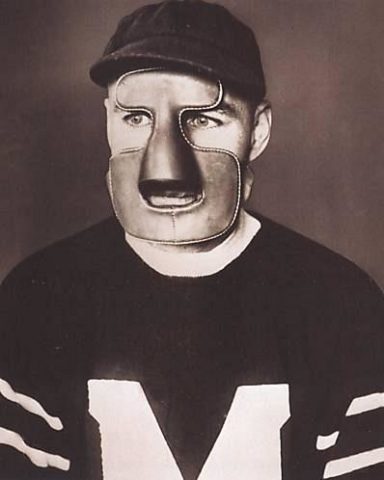
Praying Benny - Clinton Stevenson Benedict
Clinton Stevenson Benedict
Section 19, Lot 80 SW
Born in Ottawa on September 26, 1894, Clinton Stevenson Benedict was a member of four Stanley Cup–winning teams. His career as a goaltender began in childhood, when he attended Archibald Street School where he played goal for the junior fourth grade squad.

Benedict played senior-level hockey at 17, playing for the Ottawa Stewartons of the Ottawa City Hockey League in 1909–10, moving to the Ottawa New Edinburghs of the Interprovincial Amateur Hockey Union (IPAHU) the following season. Benedict joined the Ottawa Senators of the National Hockey Association (NHA) in the 1912–13 season. Although the Senators had at the time future Hockey Hall of Famer Percy LeSueur as their starting goaltender, Benedict played 10 games for the club.
Following a stellar amateur career, Benedict joined the Ottawa Senators in 1912 as a back-up goalie. Two years later he took over as the regular goalie. In those years, goalies were not allowed to fall on the puck to trap it.
They had to remain upright. Dubbed “Praying Benny,” Benedict got around the rule by pretending to fall on the puck accidentally, resulting in the rule eventually being relaxed.
Clint Benedict greatly influenced goaltending as we know it. He was responsible for a significant rule change that allowed goalies to leave their feet to stop the puck. Originally, and unthinkable to today's fans, goalies would be given a 2 minute penalty for falling on the ice to make a save.
But Benedict made an art out of the accidental fall on the puck, admitting that "if you did it a bit sneaky and made it look accidental, you could fall on the puck without being penalized." These comments made NHL rule makers aware of the problem and from that point on goaltenders were allowed to fall to the ice to stop pucks. He spent so much time on the ice he quickly earned the nickname Praying Bennie.
Benedict was with the Senators for 12 seasons, winning three Stanley Cups. He then played six years with the Montreal Maroons, winning another Cup.
In 1930, some 30 years before Jacques Plante popularized the goalie mask, Clint was the first goalie to wear facial protection in the NHL with the Montreal Maroons using it for five games during the 1929–30 season.
He was wearing the protector that looked like it had been made partially out of leather and it covered much of the front of his face. The mask itself was manufactured by a Boston sporting company and was sometimes compared to a football face guard or boxer’s sparring mask.
On January 7, 1930, he was hit by a shot from Howie Morenz in the face, breaking the bridge of his nose. Benedict was out of action for six weeks. He returned on February 20, 1930 against the New York Americans wearing the mask. He played with a mask for five games in total and according to author Douglas Hunter, Benedict modified or tried different masks during the sequence of games. His last game wearing a mask was on March 4, 1930 when he got hit in the face during a goal-mouth scramble.
He had to leave the game due to blood coming from his nose. When asked about his short-lived face mask Benedict remarked: It was leather with a big nosepiece. The nosepiece proved to be the problem, because it obscured my vision.
In 1932, Benedict became manager and coach of Saint John Beavers of the Maritime Senior Hockey League, a position he held for two seasons. Following his hockey career, Benedict returned to Ottawa, working as a municipal clerk.
He lived for many years within a five-minute walk of the Ottawa Auditorium where he played when the rink opened in 1923.
He was inducted into the Hockey Hall of Fame in 1965. Benedict is considered one of the top goalies in the history of the NHL. Clinton Stevenson Benedict died in Ottawa, November 12, 1976.


